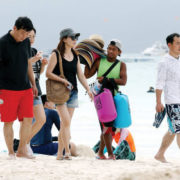Six-month closure of world-famous island begins
The Philippine government has allotted P448 million in assistance for workers affected by the temporary closure of Boracay island.
In a statement on Friday, April 27, the Department of Budget and Management (DBM) said the funds will be used for “emergency employment, livelihood, and training programs for the 6-month shutdown and rehabilitation of the resort island.”
The financial aid will cover about 17,700 formal sector workers in Malay, Aklan, who were affected by the world-famous island’s six-month shutdown.
According to Budget Secretary Benjamin Diokno, the funds came from the P13 billion Contingent Fund included in the 2018 General Appropriations Act.
This assistance is also separate from the P2 billion calamity fund, which is allocated for both registered and informal workers in Boracay.
President Rodrigo Duterte has placed Boracay under a state of calamity on Thursday, April 26, the same day when the island’s six-month closure began.
Duterte has signed Proclamation No. 475, declaring barangays Balabag, Manoc-Manoc, and Yapak in the town of Malay under a state of calamity “until lifted by the president, notwithstanding the lapse of the six-month closure period.”
Boracay will be closed until October 25 as part of the government’s efforts to address the top-ranked island’s environmental woes.
Earlier this week, the Philippine National Police (PNP) announced that it will deploy 400 of its officers to monitor the island amid its closing.
PNP Director General Oscar Albayalde on Monday, April 23, said that Chief Superintendent Cesar Binag, regional director for the Western Visayas, will be “in full control and supervision” and will have the “responsibility on how to deal with the misdeeds” in Boracay.
“We will monitor that (Boracay situation) 24 hours a day. We will be implementing it on the 26th,” Albayalde said.
While the PNP is expecting less resistance, Albayalde assured the public that the police force will implement maximum tolerance against possible protesters.
With the six-month closure in effect, the island is now off-limits to both local and foreign tourists, while individuals who wish to visit Boracay for business purposes, as well as visitors of the local residents, need to secure a permit from authorities first.
The proclamation cited several violations that led to Boracay’s shut down, such as the high concentration of fecal coliform due to insufficient sewer lines and illegal discharge of untreated wastewater into the beach.
Aside from waste management violations, it also mentioned the illegal construction on forestland and wetlands.
In February, the Department of Environment and Natural Resources (DENR) sent around 207 notices of violation to various establishments.
The DENR said about 579 structures “along the main road” are also facing demolition in Boracay.
Other violations cited in Duterte’s proclamation include the degradation of the coral reefs and the coral cover of Boracay island; and the damage and destruction of the natural habitats of Puka shells, nesting grounds of marine turtles, and roosting grounds of flying foxes or fruit bats.
“It is necessary to implement urgent measures to address the above mentioned human-induced hazards, to protect and promote the health and well-being of its residents, workers and tourists, and to rehabilitate the island in order to ensure the sustainability of the area and prevent further degradation of its rich ecosystem,” the proclamation read.






